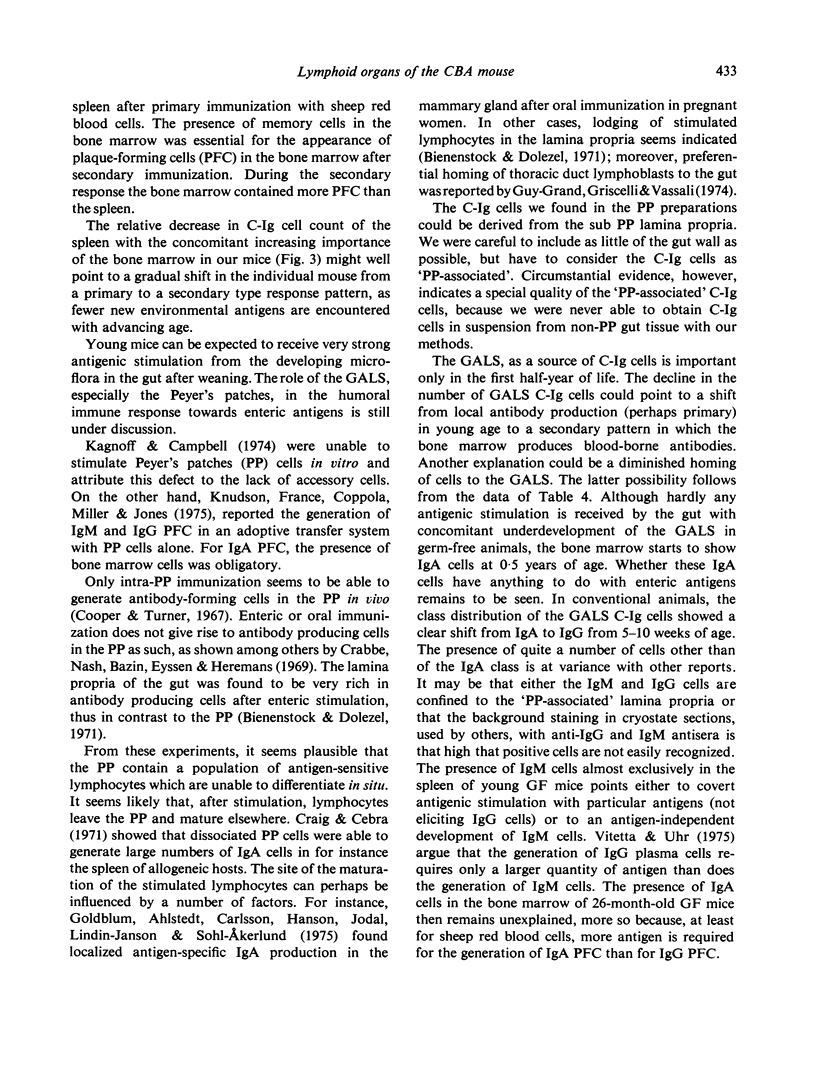Abstract
The number of cells containing cytoplasmic immunoglobulin (C-Ig cells) was determined in the spleen, mesenteric lymph nodes, bone marrow and Peyer's patches of CBA mice of different ages. A rapid increase in the number of C-Ig cells at between 2 and 6 weeks of age was observed in spleen and gut-associated lymphoid organs. The absolute number of C-Ig cells in these organs decreases with advancing age. In the bone marrow, the number of C-Ig cells increases steadily with age up to one year. From one year on, the number remains approximately constant in the males. In female mice, the number of C-Ig cells, mainly of the IgA class, increases sharply around 1 year of age. The spleen is the major site of Ig synthesis up to about 6 months of age. In older animals, the relative contribution of the bone marrow increases with age, possibly due to a gradual shift in the individual animal from primary type responses to a pattern of secondary type responses. No indication of a decreased overall immunological activity in senescence was obtained.
Full text
PDF







Selected References
These references are in PubMed. This may not be the complete list of references from this article.
- Bienenstock J., Dolezel J. Peyer's patches: lack of specific antibody-containing cells after oral and parenteral immunization. J Immunol. 1971 Apr;106(4):938–945. [PubMed] [Google Scholar]
- Bloemmen F. J., Rádl J., Haaijman J. J., Van den Berg P., Schuit H. R., Hijmans W. Microfluorometric evaluation of the specificity of fluorescent antisera against mouse immunoglobulins with the defined antigen substrate spheres (DASS) system. J Immunol Methods. 1976;10(4):337–355. doi: 10.1016/0022-1759(76)90028-4. [DOI] [PubMed] [Google Scholar]
- Cooper G. N., Turner K. Immunological responses in rats following antigenic stimulation of Peyer's patches. I. Characteristics of the primary response. Aust J Exp Biol Med Sci. 1967 Aug;45(4):363–378. doi: 10.1038/icb.1967.36. [DOI] [PubMed] [Google Scholar]
- Crabbé P. A., Nash D. R., Bazin H., Eyssen D. V., Heremans J. F. Antibodies of the IgA type in intestinal plasma cells of germfree mice after oral or parenteral immunization with ferritin. J Exp Med. 1969 Oct 1;130(4):723–744. doi: 10.1084/jem.130.4.723. [DOI] [PMC free article] [PubMed] [Google Scholar]
- Craig S. W., Cebra J. J. Peyer's patches: an enriched source of precursors for IgA-producing immunocytes in the rabbit. J Exp Med. 1971 Jul 1;134(1):188–200. doi: 10.1084/jem.134.1.188. [DOI] [PMC free article] [PubMed] [Google Scholar]
- Goldblum R. M., Ahlstedt S., Carlsson B., Hanson L. A., Jodal U., Lidin-Janson G., Sohl-Akerlund A. Antibody-forming cells in human colostrum after oral immunisation. Nature. 1975 Oct 30;257(5529):797–798. doi: 10.1038/257797a0. [DOI] [PubMed] [Google Scholar]
- Guy-Grand D., Griscelli C., Vassalli P. The gut-associated lymphoid system: nature and properties of the large dividing cells. Eur J Immunol. 1974 Jun;4(6):435–443. doi: 10.1002/eji.1830040610. [DOI] [PubMed] [Google Scholar]
- Harrison D. E., Doubleday J. W. Normal function of immunologic stem cells from aged mice. J Immunol. 1975 Apr;114(4):1314–1317. [PubMed] [Google Scholar]
- Hijmans W., Schuit H. R., Klein F. An immunofluorescence procedure for the detection of intracellular immunoglobulins. Clin Exp Immunol. 1969 Apr;4(4):457–472. [PMC free article] [PubMed] [Google Scholar]
- Kagnoff M. F., Campbell S. Functional characteristics of Peyer's patch lymphoid cells. I. Induction of humoral antibody and cell-mediated allograft reactions. J Exp Med. 1974 Feb 1;139(2):398–406. doi: 10.1084/jem.139.2.398. [DOI] [PMC free article] [PubMed] [Google Scholar]
- Knudson K. C., France C. M., Coppola E. D., Miller H. C., Jones T. L. Interaction between cells of Peyer's patches and cells of bone marrow origin in the immune response. J Immunol. 1975 Apr;114(4):1428–1430. [PubMed] [Google Scholar]
- Makinodan T., Adler W. H. Effects of aging on the differentiation and proliferation potentials of cells of the immune system. Fed Proc. 1975 Feb;34(2):153–158. [PubMed] [Google Scholar]
- Makinodan T., Peterson W. J. Secondary antibody-forming potential of mice in relation to age--its significance in senescence. Dev Biol. 1966 Aug;14(1):96–111. doi: 10.1016/0012-1606(66)90007-8. [DOI] [PubMed] [Google Scholar]
- Rádl J., Hollander C. F. Homogeneous immunoglobulins in sera of mice during aging. J Immunol. 1974 Jun;112(6):2271–2273. [PubMed] [Google Scholar]
- Stutman O. Lymphocyte subpopulations in NZB mice: deficit of thymus-dependent lymphocytes. J Immunol. 1972 Sep;109(3):602–611. [PubMed] [Google Scholar]
- Vitetta E. S., Uhr J. W. Immunoglobulin-receptors revisited. Science. 1975 Sep 19;189(4207):964–969. doi: 10.1126/science.1083069. [DOI] [PubMed] [Google Scholar]


